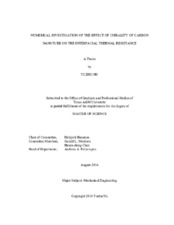| dc.description.abstract | Concentrated Solar Power (CSP) systems are used widely as a stable and reliable renewable source of energy. However, intermittency of this power source and the variability in demand for electrical power creates challenges that necessitate the integration with energy storage for reliable dispatch of power. Thermal Energy Storage (TES) systems provide a cheap, cost-effective and reliable option for energy storage in renewable power delivery systems. Due to their low vapor pressures at elevated temperatures, molten salts and their eutectics are used in conventional high temperature thermal energy storage (TES) systems and also as coolants for energy conversion, such as in power tower configurations that are typically used in CSP applications. A major drawback of the molten salts is their relatively poor thermo-physical properties, which may lead to lower systemic efficiencies in CSP/TES. Recent reports in the literature have shown that doping molten salts with nanoparticles at minute concentrations (typically less than 5% mass fraction and ideally at less than 1-2% mass fraction) can significantly enhance the thermo-physical properties of these nanomaterial (also termed as “nanocomposites” in solid state and “nanofluids” in liquid state). The dominant factor that controls the resultant thermo-physical properties of these nanomaterials is the interfacial thermal resistance (or Kapitza Resistance “R_(k)”) that impedes the heat transfer between the nanoparticle surface and the bulk solvent molecules.
In this study, the interfacial thermal resistance between a carbon nanotube (CNT) and carbonate molten salt eutectics were calculated by using numerical models that were then implemented in Molecular Dynamics (MD) simulations. The estimates for “R_(k)” obtained from these simulations enabled the prediction of the optimum dimensions of the nanoparticles for maximizing the thermo-physical properties of the mixture, i.e. thermal conductivity and specific heat capacity values of these nanomaterial. The simulations were restricted to the carbonate salt eutectic, which is composed of a molar ratio of 62:38 for lithium carbonate (Li_(2)CO_(3)) and potassium carbonate (K_(2)CO_(3)). In this study, parametric simulations were performed to estimate the values of “R_(k)” by varying the chirality of a single walled CNT (i.e, for armchair, chiral, and zig-zag CNT). The results show that the Kapitza resistance of the CNT is significantly affected by the change in the chirality of the CNT. | en |


